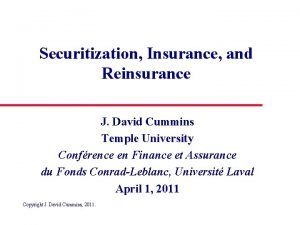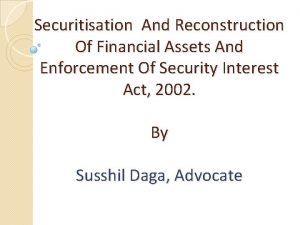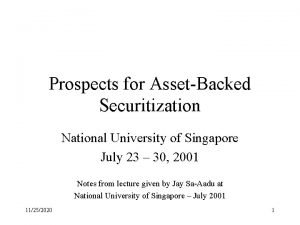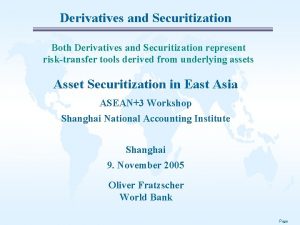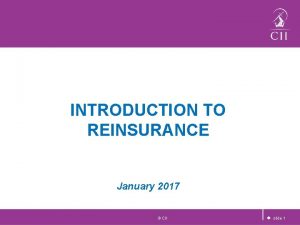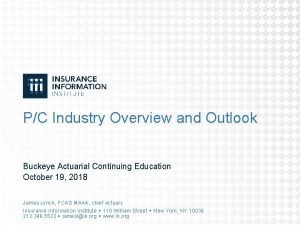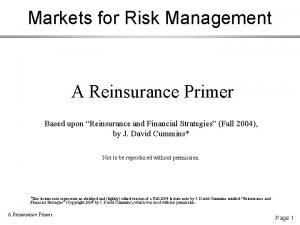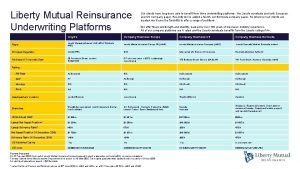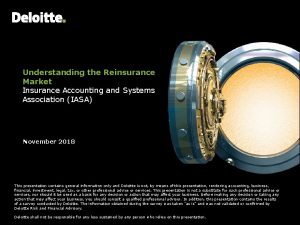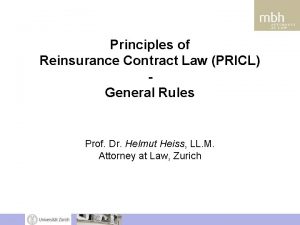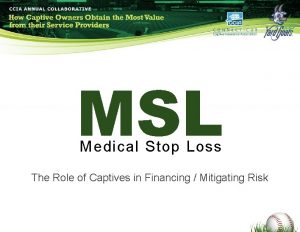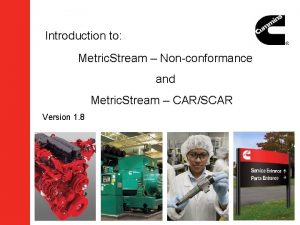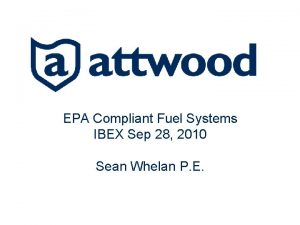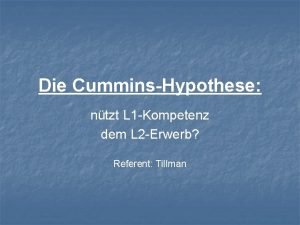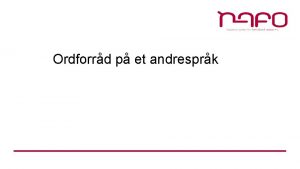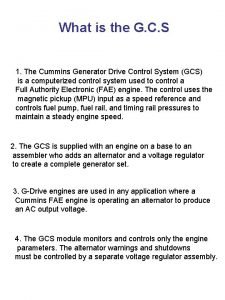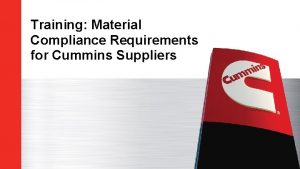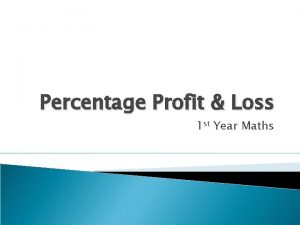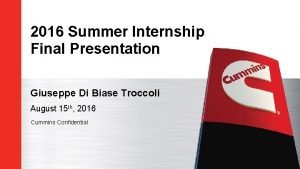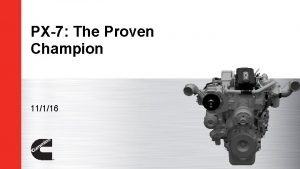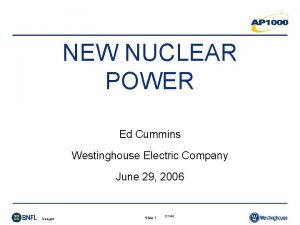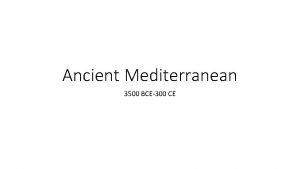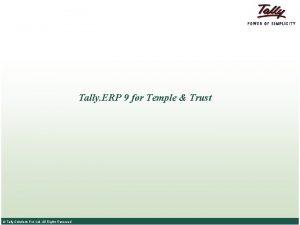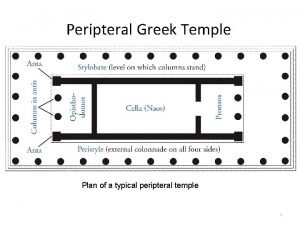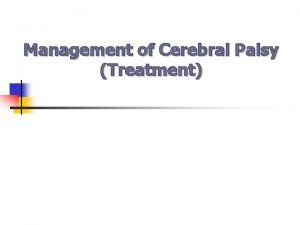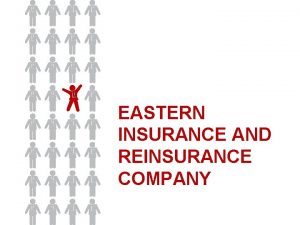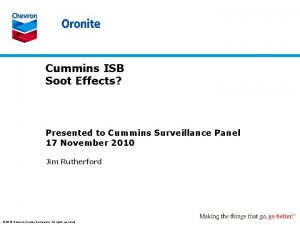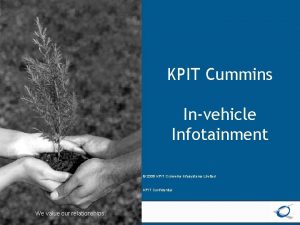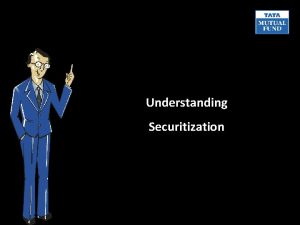Securitization Insurance and Reinsurance J David Cummins Temple







































































- Slides: 71

Securitization, Insurance, and Reinsurance J. David Cummins Temple University Conférence en Finance et Assurance du Fonds Conrad-Leblanc, Université Laval April 1, 2011 Copyright J. David Cummins, 2011.

Outline of Presentation u The catastrophe risk financing problem u Reinsurance: The traditional risk warehouse model The risk warehouse: strengths and limitations Ø Pricing with correlated risks Ø u Securitization: Focus on insurance-linked bonds Financing risk through securitization Ø Strengths and weaknesses Ø u Reinsurance u Conclusions and CAT bonds: Market size & pricing

The Catastrophe Risk Financing Problem

Number of Worldwide Insured Catastrophes No. Cats increases from < 150 per year to > 300 per year. 450 Man-Made Natural 400 No. of CATs 350 300 250 200 150 100 50 Source: Swiss Re (2010). 2008 2006 2004 2002 2000 1998 1996 1994 1992 1990 1988 1986 1984 1982 1980 1978 1976 1974 1972 1970 0

Worldwide Insured Catastrophe Losses Cat losses increase from < $10 B per year up to > $100 B. 120 Man-made 80 60 40 Source: Swiss Re (2010). 2008 2006 2004 2002 2000 1998 1996 1994 1992 1990 1988 1986 1984 1982 1980 1978 1976 1974 0 1972 20 1970 Billions (2009 $) 100 Natural

Fifteen Most Costly Insured Disasters Worldwide: 1970 -2009 (2008$) Loss US$ Millions 0 20, 000 40, 000 60, 000 H Katrina 05 H Andrew 92 WTC 9/11 01 Northridge 94 H Ike 08 H Ivan 04 H Wilma 05 H Rita 05 H Charley 04 Typh Mireille 91 H Hugo 89 Wstorm Daria 90 Wstrm Lothar 99 Eur Storm 07 Eur Storms 87 Disasters: 13 of top 15 since 1990, 8 of top 15 since 2000 Source: Swiss Re (2009, 2010).

Financing Catastrophes: Conclusions & Questions u Costs Ø of catastrophes have increased over time Significant increases in both frequency and severity u Can the global (re)insurance industry adequately finance this type of risk? Resources of insurers and reinsurers Ø Market imperfections impeding risk financing Ø u Can securitization play a significant role in financing catastrophes?

Reinsurance: The Traditional Model for Financing Catastrophic Risk

Traditional Insurer Model: Risk-Warehousing and Risk-Bearing Hedgers: Individuals & Firms Risk Transfer & Premium Contingent Payment Risk Warehouse: Primary Insurer Internal Risk Diversification Risk Transfer & Premium Contingent Payment Equity Risk-Bearing: Equity Capital Dividends Risk Warehouse: Reinsurer Shareholders: Portfolio Diversif.

How the Risk Warehouse Works u Hedgers transfer risks to the risk warehouse u The risk warehouse internalizes risk diversification Across policyholders Ø Across lines of insurance Ø Geographically Ø u Diversification does not eliminate all risk Some risk is transferred to reinsurers but reinsurance can be expensive, so residual risk remains Ø Residual risk is borne by the insurer’s stockholders, who diversify by holding stocks and bonds in other industries across the economy Ø

Limitations of Risk Warehousing u Risk warehouses are very efficient in handling relatively small, independent risks & many larger risks that are not correlated u Factors exist that create inefficiencies such that warehousing may become too costly Events causing extremely large losses relative to the (re)insurance industry’s equity capital Ø Risks that are correlated (theory of insurance is mostly based on independent risks) Ø Capital market imperfections that raise the cost of capital for insurers and reinsurers Ø

Limitations of Risk Warehousing II u Premium Ø = E(L) + Expense Loading + Risk Loading Risk loading = Required capital*Cost of capital u Large risks and correlated risks raise the required capital for a given insolvency or Va. R target u Capital market imperfections for such risks raise the costs of capital u Therefore, the risk loading may be excessive, destroying “gains from trade” in the insurance market

Illustrating Effects of Correlated Risks on Cost of Capital and Insurance Pricing u Diversification and pricing illustrated using a simple mean-variance model Insurance portfolio consists of N risks, X 1, . . . , XN Ø Risks have finite means and variances Ø Risks have pairwise covariances which are not necessarily equal to 0 Ø The average mean in the sample is , the average variance is and the average covariance is Ø u In the limit, the sum of the risks is assumed to approach normality Ø Results would hold even more strongly for skewed risks

Assumptions About the Insurer u Insurer is assumed to set premiums to cover expected losses plus a risk-charge u The risk charge is calculated to achieve a target probability of insolvency, ε (Tail Va. R) u The insurer raises equity capital in the capital market at unit price

Why Is Ruin Probability Not = 0? u Capital is costly due to Agency costs of operating an insurance company Ø Regulatory costs Ø Corporate income taxation Ø Informational asymmetries between insurers and capital market Ø Accounting rules regarding treatment of reinsurance, etc. Ø u Therefore, insurer does not hold enough capital to reduce insolvency probability to zero

Calculating Ruin Probability: Central Limit Theorem

Equity Capital Per Policy to Achieve Ruin Target: Correlated Risks “Equity capital per policy to achieve ruin probability target = ε. ”

Capital Per Policy: Limiting Value u Therefore, unlike the case of independent risks, the risk charge does not go to zero in the limit

Cost of Capital for New Policies

Cost of Capital for New Policies: Discussion u Incorporates the conventional CAPM beta term u Adds a term reflecting non-systematic covariability with existing risk portfolio u Adds a term for the contribution of the new risk (risk i) to portfolio return skewness Ø Again this does not have to be market systematic risk in the conventional CAPM sense u Model is based on Froot, Journal of Risk and Insurance (2007).

Why Non-Systematic Risk is Priced u Non-systematic covariability and skewness risk increase the probability that the firm will need to raise external capital due to loss shocks u External capital is more expensive than internal capital (retained earnings) Following a shock, cost of external capital rises, leading insurers to have to pass up attractive projects Ø Therefore, policies with high contributions to covariability and skewness have higher costs of capital Ø u Insurance buyers are more sensitive to insolvency risk than bond holders in corporations because insurer insolvency not diversifiable for buyers

Why Is External Capital More Costly u Informational asymmetries between insurers and capital markets Insurer knows more about its risk exposure and project riskiness than investors Ø Investors demand a premium to protect against possibly higher risk levels Ø u Agency costs of monitoring managers who may act in their own interests rather than the owners’ interests u Insurers invest in informationally intensive, illiquid assets that cannot be fully hedged in financial markets, e. g. , liability insurance policies, catastrophe insurance

Capital, Convexity, and Risk Premia u Information asymmetries, agency costs and other factors lead to convex costs of raising new capital Ø Per unit cost of capital increases in the amount of capital required u The risk premia ( ) are Increasing in convexity of the cost of capital Ø Decreasing in the amount of internal funds held Ø u Thus, firms with high costs of external funds and relatively low capital charge higher prices u Helps to explain (re)insurance underwriting cycles

Premium With Correlated Risks “Expenses assumed to equal zero. ”

Premium With Correlated Risks: XOL Reinsurance u Effects of covariability likely to be larger for excess of loss (XOL) reinsurance, which is more risky and highly skewed u Payoff to XOL reinsurance is similar to a call option spread: u Where XR = reinsurance payoff α = coinsurance proportion M = point of attachment (lower strike) U = coverage limit (upper strike) U>M

Premium with Correlated Risks: Assumptions for Illustration u Portfolio of identically distributed risks Frequency distribution: Poisson (λ = 0. 1) Ø Severity distribution: Lognormal (μ = 10, σ = 0. 8) Ø Average correlation among risks varies from 0 to 0. 35 in increments of 0. 05 Ø u Lognormal Mean = 30, 333. 3 Ø Standard deviation = 28, 720. 3 Ø u Total claims distribution Mean = 3, 033. 3 Ø Standard deviation = 13, 209. 7 Ø

Premium with Correlated Risks: Assumptions for Illustration u Cost of capital 10% to illustrate CAPM-type cost of capital Ø 15% to illustrate cost of capital with loadings for nonsystematic covariability and skewness Ø u Premiums for a layer of reinsurance Attachment point M = 25, 000 Ø Upper limit U = 45, 000 Ø u Expected value of loss in the layer = 582. 66

Premium with Correlated Risks: Function of Average Correlation and Cost of Capital Premium/Expected Loss, Reinsurance Layer, Ruin Probability = 0. 001 4. 0 Rc = 15% 3. 0 2. 5 2. 0 1. 5 Average Correlation 5 0. 3 5 0. 2 5 0. 1 0. 0 5 1. 0 0 Premium/E(L) 3. 5 Rc = 10%

Premiums with Correlated Risks: Conclusions u Risk correlations raise the amount of capital required to achieve a specified probability of ruin Moderate correlations (5% or 10%) produce premiums 1. 5 to 2. 5 times the expected loss Ø Higher correlations (e. g. , 20%) produce premiums 2. 5 to 3. 25 times the expected loss Ø u Raising the cost of capital also increases the premium significantly Ø At 10% risk correlation, raising cost of capital from 10% to 15% raises the premium by 25% u Therefore, correlations and capital costs can lead to severe insurance market problems

Traditional Reinsurance Model: Advantages u Internalizing the benefits of law of large numbers, reinsurers achieve a high degree of diversification u High diversification means that a small amount of equity capital can support policy limits many hundreds of times large than the capital itself u By warehousing over a period of time, the reinsurer accumulates significant amounts of information on underwriting, pricing, and risk management Economies of scale in information acquisition & analysis Ø Provides information to clients at low cost Ø

Reinsurance Model: Disadvantages u Warehousing reinsurance contracts internally creates information opacities with securities markets Increases informational asymmetries Ø Raises the cost of capital Ø u Reinsurer capital costs are high because of agency costs, corporate income taxation, and other factors u Reinsurance market subject to underwriting cycles – periodic pricing and availability problems u Reinsurance market not efficient for correlated, highly skewed risks that are large relative to industry capital

Securitization: A New Model for Financing Catastrophic Risk

Securitization: Resolving Reinsurance Market Inefficiencies u Risks that are correlated within reinsurance markets may be uncorrelated with other economic risks u Magnitude of largest insured risks is large relative to equity capital of reinsurers But small relative to capitalization of securities markets Ø $100 billion event has probability of 1 to 2% Ø $100 billion is large relative to reinsurer equity but < 0. 5% of value of US stock and bond markets Ø u Securitization can reduce or eliminate credit risk that is present in reinsurance markets

Hybrid and Securitized Products u Hybrid products Industry loss warranties (ILWs) Ø Sidecars Ø Collateralized reinsurance Ø u Securitized products CAT futures and options Ø Insurance-linked swaps Ø CAT bonds Ø Other insurance-linked bonds (e. g. , auto insurance) Ø Contingent capital Ø Mortality and longevity bonds Ø

Securitization Through Insurance-Linked Bonds u Hedgers transfer risks to the risk warehouse (reinsurer) u Risk warehouse retains some risks through internal diversification, equity capital, and reinsurance u Efficient to securitize some risks Risk transferred to special purpose vehicle (SPV) and held off-balance-sheet Ø SPV issues securities to investors and receives proceeds Ø SPV puts proceeds in trust, invested in safe assets Ø SPV issues a call option (XOL reinsurance) to reinsurer Ø Insurer pays premium (expected loss + risk spread) to SPV Ø SPV pays premium to investors Ø

Securitization Through Insurance-Linked Bonds II u For correlated risks (e. g. , catastrophes), reinsurance premiums may be too high Such risks are large relative to reinsurer capital Ø Capital needed to achieve ruin target raise prices Ø u Securitization transfers risk to investors holding broadly diversified portfolios CAT risk small relative to securities markets Ø CAT risk uncorrelated with most events that move markets Ø § Therefore, CAT bonds valuable for diversification Ø CAT bonds are a “pure-play” on catastrophe risk § Not exposed to frictional costs of investing in insurer equity capital

Securitization Through Insurance-Linked Bonds III u Insurance-linked bonds are fully collateralized On occurrence of event, funds are released to reinsurer Ø If no event, funds returned to investors at maturity Ø u Full Ø collateralization: Advantages Limited counterparty credit risk contingent on § Credit quality of swap counterparty § Appropriate restrictions on investment of SPV assets Ø Funds available quickly following an event u Full collateralization: Disadvantage? Amount of coverage = funds in SPV Ø No leveraging of equity capital as in traditional reinsurance Ø

Why Use a Special Purpose Vehicle? u The SPV is a “passive financial intermediary” that exists to Insulate investors from sponsor’s credit risk Ø Provide transparent servicing of asset/liability Ø Structure tranches of debt to appeal to different classes of investors Ø Insulate investors from agency costs of issuer, creating a “pure play” security Ø Provide tax and accounting benefits to sponsor Ø

Insurance-Linked Bonds: Advantages to Investors u Low correlations with other types of investments such as stocks, bonds, mortgage-backed securities u Full collateralization reduces credit risk u Provide a “pure play” in catastrophe risk u Less complex and more transparent than mortgage backed securities and CDOs u Lower moral hazard than mortgage-backed securities Issuing reinsurer remains responsible for covered risks, providing incentives for proper risk management Ø Reinsurer and investors have incentive to invest trust assets in safe securities Ø

Insurance-Linked Bonds and Reinsurance: Market Size and Pricing

Global Reinsurers: Resources In 2009: $426 billion equity, $161 billion premiums 700, 000 600, 000 500, 000 400, 000 300, 000 200, 000 100, 000 Equity Premiums 20 09 20 08 20 07 20 06 20 05 20 04 20 03 20 02 20 01 20 00 19 99 0

Top 10 Global Reinsurers: 2009 Group Name Country Swiss Re Switzerland $32, 462 Munich Re Germany $22, 892 Hannover Re Germany $13, 341 Berkshire Hathaway U. S. $11, 399 Lloyd's of London U. K. $9, 732 SCOR France $8, 314 RGA Reinsurance U. K. $5, 725 Transatlantic U. K. $3, 986 Partner Re Bermuda $3, 942 Everest Re Bermuda $3, 929 Source: A. M. Best 2010 Global Reinsurance Special Report, September 6, 2010. Gross Premiums

Global Reinsurers: Equity & CAT Losses 500 400 300 200 35% 30% 25% 20% 15% 100 5% - 0% CAT Loss/Equity (%) CAT Loss/Equity 19 99 20 00 20 01 20 02 20 03 20 04 20 05 20 06 20 07 20 08 20 09 Equity (2009 $US B) 600 Equity Dollar values deflated to 2009 real values using the CPI. Equity from S&P GRH (various years), CAT Losses from Swiss Re (2010).

Reinsurance Cycles: World Rate on Line Index for Cat Reinsurance Rate on line = Premium/Maximum Contract Payout 400 350 300 250 200 150 100 50 19 9 19 1 92 19 93 19 9 19 4 95 19 96 19 9 19 7 98 19 99 20 0 01 20 0 20 2 0 20 3 04 20 0 20 5 0 20 6 07 20 0 20 8 0 20 9 10 0 Source: Guy Carpenter (2010).

Reinsurance Rates on Line: Comment u Rates on line are Highly cyclical Ø Correlated across national markets, reflecting the truly global market for reinsurance Ø Tend to spike after large catastrophes such as Ø § Andrew (1992) § World Trade Center (2001) § Katrina-Rita-Wilma (2005) Ø Rate on line spikes correlated with supply restrictions

30 Volume No. Deals Source: Swiss Re (2010), GC Securities (2008). A. M. Best Reinsurance Study (2008), AON (2009), 2010 data through July 31. 25 20 15 10 5 0 Number of Deals 9, 000 8, 000 7, 000 6, 000 5, 000 4, 000 3, 000 2, 000 1, 000 0 19 97 19 98 19 99 20 00 20 01 20 02 20 03 20 04 20 05 20 06 20 07 20 08 20 09 20 10 Volume ($ US Millions) CAT Bonds: New Issue Volume & Deals

CAT Bonds: Risk Capital Outstanding 18, 000 US $ (Millions) 16, 000 14, 000 12, 000 10, 000 8, 000 6, 000 4, 000 2, 000 19 97 19 98 19 99 20 00 20 01 20 02 20 03 20 04 20 05 20 06 20 07 20 08 20 09 20 10 0 Source: Swiss Re (2010), 2010 data through July 31.

Reinsurance: Post-Disaster Capital Raising 12, 000 “Cat Bonds and Sidecars accounted for 34% of new capital following 2005 hurricanes. ” US $ (Millions) 10, 000 8, 000 Start-ups Recap Cat. Bonds Sidecars 6, 000 4, 000 2, 000 0 1992 -1993 Source: Guy Carpenter (2009). 2001 -2002 2005 -2006

CAT Bond Investors Year-ending June 30, 2010 Hedge Mutual Reinsurers Funds 20% 6% 4% Institutions 31% Cat Funds 39%

CAT Bonds By Peril Year-ending June 30, 2010 EU Wind 8% Other 6% US Hurr 55% US EQ 30% Japan 1%

Example: The Mexican CAT Bond u In March 2006, the Mexican government purchased $US 450 M earthquake catastrophe coverage u $160 million was raised through a CAT bond u Parametric bond – payoff based on earthquake characteristics u Bond premium very low: 2. 5% Ø Reflects diversification relative to “peak risks” in the U. S. , Europe, and Japan, i. e. , Mexico “off peak”

The Mexican CAT Bond Characteristics Class A Notes Class B Notes Principal: US$150 M US$10 M Covered Territory: Zone B Zones A and C Annual Expected Loss: 0. 96% 0. 93% Principal Reduction Mechanism: Binary, first Zone to Trigger Rating (S&P): BB+ Investor Spread (bps) LIBOR + [235] LIBOR + [230] Multiple (spread/exp loss) 2. 45 2. 47

CAT Bonds vs. Reinsurance: Why Price Comparison is Difficult u CAT bonds usually multi-year whereas reinsurance tends to be for one year u Reinsurance contracts contain reinstatement provisions whereas CAT bonds usually do not u CAT bonds have very low or no credit risk whereas reinsurance has credit risk

Q 4 Q 1 Q 2 Q 3 Q 20 3 05 Q 20 2 06 Q 20 1 06 Q 20 4 07 Q 20 3 08 Q 20 2 09 Q 20 1 09 Q 20 4 10 Q 3 04 20 03 20 02 20 01 20 Premium/E(L) CAT Bond Pricing: Premium/Expected Loss 7 6 5 4 3 2 1 0 Source: Lane Financial (2010).

Reinsurance Prices: Rate on Line versus Loss on Line Source: Guy Carpenter.

CAT Bond Yields vs. Reinsurance u In the 1 to 2% loss on line range, reinsurance price spreads versus Cat bond spreads 2005: Ø 2006: Ø 2007: Ø 2008: Ø 4 to 6 reinsurance vs 2 to 3 Cat bonds 7 to 13 reinsurance vs 5 to 7 Cat bonds 4 to 5 reinsurance vs 4 to 5 Cat bonds 3 to 4 reinsurance vs 3 for Cat bonds u Therefore, Cat bonds are priced comparably with reinsurance in recent years

January-98 April-98 June-98 September-98 December-98 March-99 June-99 September-99 December-99 March-00 June-00 September-00 December-00 March-01 June-01 September-01 December-01 March-02 June-02 September-02 December-02 March-03 June-03 September-03 December-03 February-04 May-04 August-04 November-04 February-05 May-05 August-05 November-05 February-06 May-06 August-06 November-06 February-07 May-07 August-07 November-07 February-08 YTM OR COUPON (%) Yields: CAT Bonds & Corporates (BB) 16 15 14 13 12 11 10 9 8 7 6 5 4 BB CORP (1 -10 year) BB Catastrophe Bonds 4 per. Mov. Avg. (BB Catastrophe Bonds)

CAT Bond Yields vs. BB Corporates u During most of period, CAT bonds priced comparable to corporates u However, during significant part of the period, CAT bonds had higher yields u CAT bond yields also more volatile than for corporates Ø In part, reflects thinness of market

CAT Bonds: Explaining the Spreads u Original pricing argument: CAT risk is “zero-beta” Ø Therefore, CAPM implies pricing at the risk-free rate Ø u However, spreads are much higher than risk-free rate – why does this happen? “Novelty premium” – investor unfamiliarity – however, we now have dedicated CAT mutual funds Ø High costs of issuance – however, cost have declined Ø So the reason is ? ? Ø

CAT Bonds: Explaining the Spreads u “Habit-based” consumption CAPM (Campbell and Cochrane, 1999; Dieckmann, 2008) u Investor risk aversion increases as consumption falls towards its “long-run” habit level u Therefore, investors are averse to assets that have low payoffs during adverse states of the world (economic downturns or catastrophes)

Explaining the Spreads: Habit-Based Consumption Model u Utility determined by present value of consumption Campbell and Cochrane (1999), Dieckmann (2008).

Consumption-Based Pricing Model II u Relationship between consumption and habit determined by the surplus consumption ratio u St → 0 corresponds to unfavorable state of the world

Consumption-Based Pricing Model III u Relative u St risk aversion in this model is: → 0 corresponds to very high investor risk aversion

Implications of Consumption-Based Model u Investor risk aversion increases as consumption falls towards its “long-run” habit level u Therefore, investors averse to assets that have low payoffs during adverse states of the world (economic downturns) u Dieckmann provides evidence that natural catastrophes shock economic activity sufficiently to explain magnitude of CAT bond spreads Ø Shock of 2% of GDP (similar to Katrina) sufficient to explain the spreads

Conclusions

Conclusions u Reinsurance is highly efficient in dealing with the usual types of insurance market risks Losses relatively small compared to reinsurer capital Ø Risks with relatively low covariability Ø Risks with manageable variance and skewness Ø u Reinsurance facilitates long-term relationships between ceding insurers and reinsurers, reducing informational asymmetries and leading to more efficient risk sharing u Reinsurance available to insurers of all sizes, whereas securitization most efficient for large firms

Conclusions II u Securitization more efficient for relatively large risks with high covariability and skewness Ø CAT bonds have established a market niche for CAT risk financing and post-shock recapitalization u Securitization provides needed capacity to mitigate the effects of reinsurance price and availability cycles, periods when Reinsurance prices rise Ø Supply of reinsurance is restricted Ø u Securitization reduces or eliminates credit risk

Conclusions III u Risk-capital raised with insurance-linked securities has grown significantly Still small relative to reinsurance Ø Recently, bonds issued for “low layer” coverages such as automobile insurance Ø u Spreads have been declining Now comparable with corporates, reinsurance, ILWs Ø Prices remain volatile and subject to spikes following large loss events Ø “Off-peak” bonds (Mexican, etc. ) may stabilize market and reduce spreads Ø

Conclusions IV u Bonds have attracted broad market interest – dedicated CAT funds now account for majority of the market u Because they are transparent and fully collateralized, CAT bonds less exposed to the problems that befell credit default swaps (CDS) and MBS CAT bonds generally much less complex than MBS & CDOs Ø Except for a small number of bonds with Lehman as counterparty, CAT bonds did well during the 2007 -2010 crisis Ø Therefore, CAT bonds provided valuable liquidity for trading banks during the crisis Ø

Conclusions V u Other securitized structures may provide additional capacity in the future Catastrophe futures & options Ø Swaps Ø Sidecars Ø u However, for futures & options to succeed, insurers need to develop trading expertise Continual hedging operations versus Ø Buy reinsurance once a year Ø

The End Thank you!
 Insurance and reinsurance
Insurance and reinsurance Cummins insurance
Cummins insurance Securitisation and reconstruction of financial assets
Securitisation and reconstruction of financial assets Warehouse financing vs securitization
Warehouse financing vs securitization Benefits of securitization
Benefits of securitization Securitization copenhagen school
Securitization copenhagen school Life settlement securitization
Life settlement securitization What is securitization
What is securitization What is securitization
What is securitization Prabuddha ganguli
Prabuddha ganguli Fire insurance introduction
Fire insurance introduction Treaty reinsurance
Treaty reinsurance Types of reinsurance
Types of reinsurance Facultative reinsurance
Facultative reinsurance Facultative
Facultative Sava re slovenia
Sava re slovenia Milli reinsurance
Milli reinsurance Buckeye reinsurance
Buckeye reinsurance Reinsurance in a relationship
Reinsurance in a relationship Retroactive reinsurance accounting
Retroactive reinsurance accounting Reinsurance primer
Reinsurance primer Reinsurance mutual funds
Reinsurance mutual funds Finite risk reinsurance
Finite risk reinsurance Insurance accounting and systems association
Insurance accounting and systems association Towers perrin reinsurance
Towers perrin reinsurance Pricl
Pricl Captive reinsurance for stop loss
Captive reinsurance for stop loss Canadian reinsurance conference
Canadian reinsurance conference Def dosing unit relay
Def dosing unit relay Cummins isl9 crankcase pressure sensor location
Cummins isl9 crankcase pressure sensor location Common underlying proficiency
Common underlying proficiency Quickserve cummins com
Quickserve cummins com Cummins cqms
Cummins cqms Cummins isx aftertreatment fuel shut off valve location
Cummins isx aftertreatment fuel shut off valve location Eisbergmodell cummins
Eisbergmodell cummins Schwellenhypothese cummins
Schwellenhypothese cummins Cummins power products
Cummins power products Quadrante di cummins
Quadrante di cummins Tata cummins scholarship
Tata cummins scholarship Cummins model of second language acquisition
Cummins model of second language acquisition Isfjellmodellen
Isfjellmodellen Gce.cummins
Gce.cummins Cummins model of academic language
Cummins model of academic language Cummins gcs
Cummins gcs Cummins supplier portal
Cummins supplier portal Percentage profit and loss questions
Percentage profit and loss questions Cummins power products new hudson mi
Cummins power products new hudson mi Brett merritt cummins
Brett merritt cummins Cummins px7
Cummins px7 Ivor cummins debunked
Ivor cummins debunked Arkansas
Arkansas Ed cummins
Ed cummins Cpp cummins
Cpp cummins Holly cummins
Holly cummins Herod's temple facts
Herod's temple facts Temple and family history consultant
Temple and family history consultant White temple and ziggurat
White temple and ziggurat White temple and its ziggurat
White temple and its ziggurat Tuid temple
Tuid temple Salt lake temple baptismal font
Salt lake temple baptismal font Temple university study abroad
Temple university study abroad Temple operating system
Temple operating system Temple of bacchus plan
Temple of bacchus plan Temple of bacchus plan
Temple of bacchus plan Temple data analytics challenge
Temple data analytics challenge Temple accounts format
Temple accounts format Lean temple
Lean temple Irb temple
Irb temple Temple for business success
Temple for business success Fallen warrior temple of aphaia
Fallen warrior temple of aphaia Mobius strip temple
Mobius strip temple Temple fay approach
Temple fay approach

